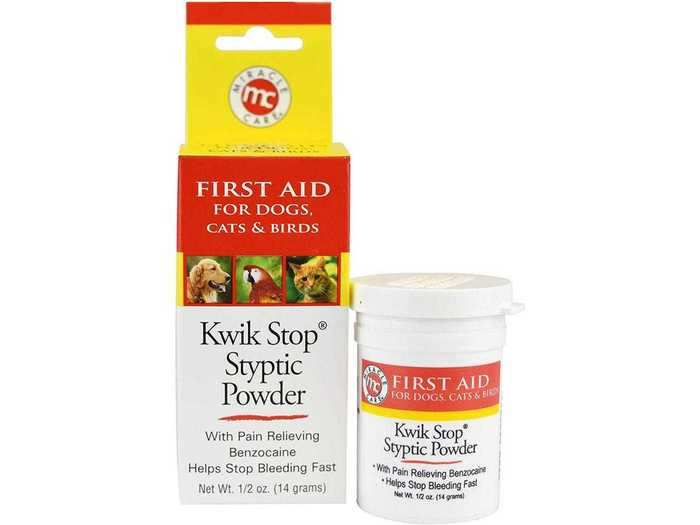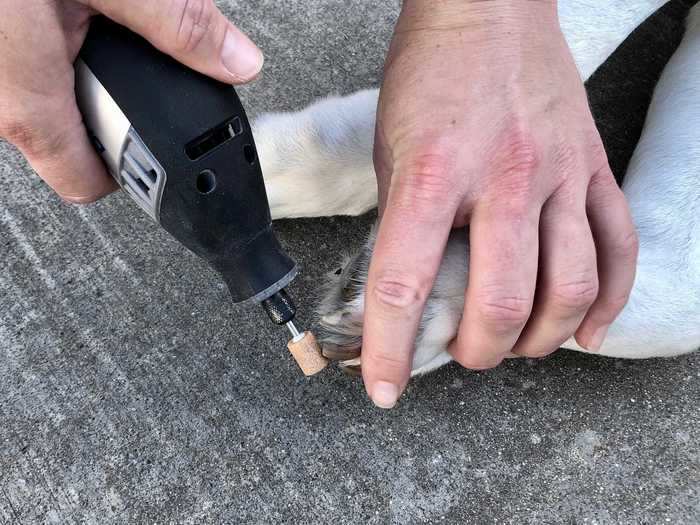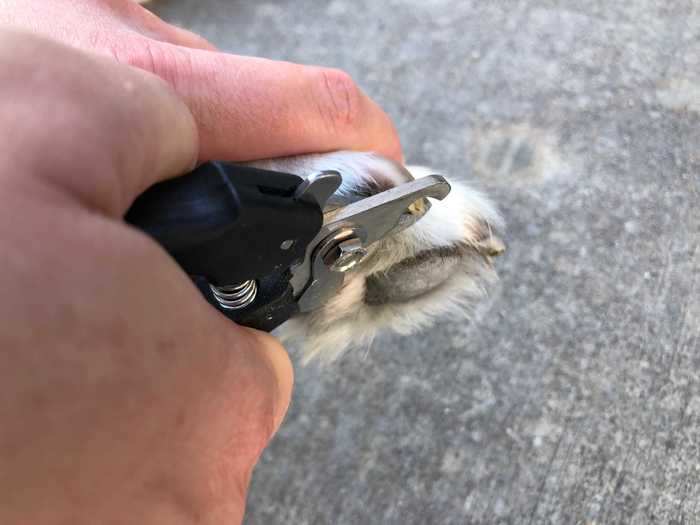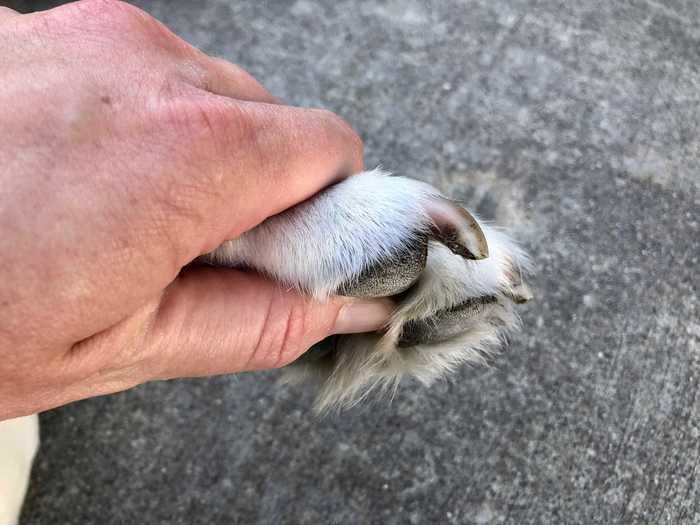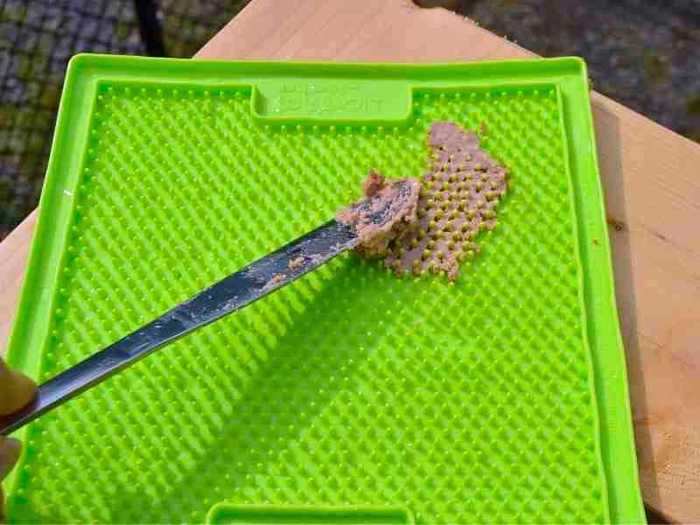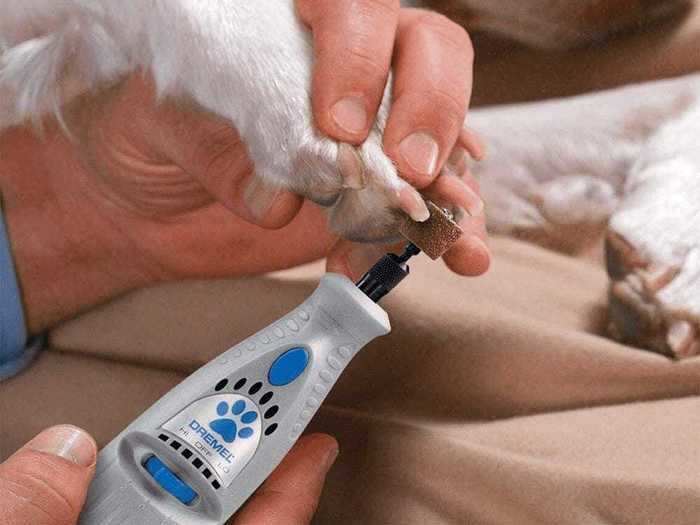Getty Images
When you buy through our links, we may earn money from our affiliate partners. Learn more.
- Trimming a dog's nails can be intimidating at first.
- But with the correct technique, tools, and a gentle approach, you can cut your dog's nails at home.
- We've broken down the steps and the products to show you how to trim a dog's nails.
- See also: the best dog nail clippers and how to clean a dog's ears
Like humans, a dog's nails grow continuously. All dogs need their nails trimmed regularly. If allowed to grow too long, they can snag on carpet or furniture, causing serious injury.
"Long nails tend to break, and then you can get a split toenail," said Dr. Grace A. Mengel, assistant professor of clinical primary care medicine at University of Pennsylvania's School of Veterinary Medicine. "It's a common emergency-room scenario: The nail splits, it's hanging on by a thread, and it's bleeding. The pet owners come into the ER, where we end up removing the nail. I used to call it the $150 nail trim. It's a good incentive to keep their nails in good condition because they might be less likely to break."
Too-long nails can also cause the feet to splay out, making it difficult for your dog to walk properly and maintain traction on the floor. Also, because most dog nails curve down, the nail can begin to curl back toward the paw as it grows. In severe cases, the nail can grow right into the skin on the paw pad, causing pain and infection.
If you have never trimmed a dog's nails, you might feel nervous or intimidated. Remember, you can always ask your veterinarian or groomer to show you how to do it. Most veterinary staff and groomers are happy to provide a quick lesson.
Here's how to trim a dog's nails step by step and what you need to do it:Read the original article on
Insider
What to do if you nick the nail
Amazon
If you accidentally cut into the quick, your dog might yelp in pain and the nail will start to bleed. "Quicked" nails can bleed a lot.
"It's not necessarily an emergency, other than the blood will get everywhere, which is very alarming to people," Mengel said. "If the next day it is still sore, if there is swelling, if the dog is lame, you will definitely want to get it checked out just in case there is an infection."
If you cut the quick, use something to assist with the clotting process. "Commonly in clinics we use styptic powder, which helps. It does sting, though," Mengel said. She recommends putting the styptic powder on a piece of gauze and then holding it against the nail and applying some pressure to help stop the bleeding. Some people also use a bar of gentle soap or cornstarch.
A nicked nail can bleed for some time. After using the styptic powder, it can help to put your dog in a crate for a while. "You have to try to keep them still because the more they run around and irritate it, the more it tends to bleed and that just gets messy," Mengel said. "Don't wrap it and leave the wrap on. You can wrap it too tight, or if you leave it on too long you can get an infection."
How to trim your dog's nails with a grinder or filer
Jackie Brown/INSIDER
Follow these steps to grind your dog's nails:
- Hold the nail grinder in one hand.
- Hold your dog's entire paw in the other hand, gently squeezing it to spread the toes.
- Isolate the nail you wish to grind, holding that toe with your thumb and index finger. If your dog has long hair, sweep it to the sides of the nail and hold it down against the toe with your thumb and index finger.
- Turn on the grinder and touch it gently to the end of the nail.
- Roll the grinder back and forth on the nail, moving slowly and smoothly.
- Repeat for each of your dog's nails. Don't forget to grind the dewclaws, if your dog has them. (Dewclaws are located higher up on the dog's paw—where you might expect to find a thumb.)
How to trim your dog's nails with clippers
Jackie Brown/INSIDER
Trim your dog's nails every one to two weeks to keep them well-maintained. When trimming this frequently, you need only snip off the very tips of the nails. The longer you go between trims, the longer the quick will grow, which can make it difficult to get the nails to a short length.
Follow these steps to clip your dog's nails:
- Hold the clippers in one hand.
- Hold your dog's entire paw in the other hand, gently squeezing it to spread the toes.
- Isolate the nail you wish to cut, holding that toe with your thumb and index finger. If your dog has long hair, sweep it to the sides of the nail and hold it down against the toe with your thumb and index finger.
- Position the clippers so they encircle the nail below the quick. If your dog has black nails, position the clippers just below the curve of the nail.
- Smoothly and swiftly close the clipper handles, snipping off the end of the nail.
- Repeat for each of your dog's nails. Don't forget to trim the dewclaws, if your dog has them. (Dewclaws are located higher up on the dog's paw — where you might expect to find a thumb.)
- Praise your dog with a soothing voice and reward them treats.
Understanding the anatomy of your dog's nails
Jackie Brown/INSIDER
Like human nails, a dog's nail is made of keratin, a hard protein. A vein, called the quick, runs down the center of each nail. The quick is filled with nerve endings. When trimming your dog's nails, it's extremely important that you do not cut the quick. Doing so will hurt your dog and cause the nail to bleed, sometimes profusely.
Depending on the color of your dog's nails, it can be difficult to know where the hard nail ends and the sensitive quick begins.
If your dog has white nails, it's fairly easy to see the quick (the pink part in the center of the nail). When clipping the nail, clip only in front of the pink part so you don't cut the quick.
If your dog has black nails, you can't see the quick. For dogs with black nails, it's best to make conservative snips off the nail a little at a time. For a good gauge of how far back to clip black nails, look at the end of the nail where it starts to narrow and curve down in a hook. Clip off the curved part of the nail only. After trimming conservatively, you can further smooth the nail down with a nail file or nail grinder. You can also skip nail trimmers entirely and just grind the nails down with a file or grinder.
Where to trim your dog's nails
Since most dogs are resistant to having their nails trimmed, it helps to put them up on a table or counter to prevent them from trying to get away from you. It's best to have a helper assist holding the dog. Have the helper hold the dog against their body with one arm under the belly and the other arm circling the dog's neck in a gentle hug.
If you don't have a helper, hold the dog against your own body so you can maintain control of the dog while trimming the nails. Alternatively, you can sit on the floor or a couch and hold your dog against your body.
How to introduce nail trimming to your dog
Christine Caplan/INSIDER
Unless they've been properly introduced to the procedure, most dogs do not enjoy having their nails trimmed. Ideally, introduce nail trimming to your puppy starting from a young age. Using lots of treats, clip one nail at a time, going slowly and reassuring your puppy using a soothing voice. Over time, they can become accustomed to accepting this necessary procedure.
You can use the same techniques for an older dog. The key is to be gentle, use upbeat verbal reassurances, and include lots of positive reinforcement with yummy treats. Peanut butter can go a long way toward gaining your dog's cooperation. Simply smear a thin layer of peanut butter on a large plate or LickiMat and place it next to your dog's face. Your dog will be distracted as they work on licking the peanut butter off the plate or mat.
How to find the right nail-trimming tools
Dremel
As with anything, you need the proper tools to trim your dog's nails safely and effectively. Don't attempt to use human nail clippers or nail scissors on your dog's nails. Dog nails are much thicker and stronger than human nails and require special nail clippers.
Dog nail trimmers come in several different styles:
Scissors: This style of dog nail clippers looks similar to wire cutters or miniature hedge clippers. Small, curved blade edges come together to clip the nail when you squeeze the handles together. A classic example of this style of nail clippers is Millers Forge Large Dog Nail Clippers.
Guillotine: This style consists of a fully enclosed loop that you insert the nail through. Squeezing the clipper handle brings a sharp blade down and across the nail to neatly slice it off. The Resco Deluxe Pet Nail Clippers is a guillotine-style clipper.
Grinders: Grinding tools like a Dremel can work wonderfully to slowly and gently file down a dog's nail. Look for a grinder made for pets, like the Dremel Cordless Pet Dog Nail Grooming and Grinding Tool or the Wahl Premium Nail Filer.
Styptic powder: If you accidentally cut the quick (the vein that runs through the nail), having some styptic powder on hand is helpful to stop the bleeding. Kwik Stop Styptic Powder is a tried-and-true brand. According to Mengel, cornstarch also works well to staunch bleeding.

